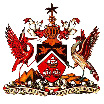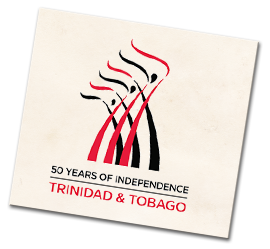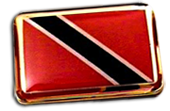THE NATIONAL FLAG
 On May 28, 1962 the historic Independence Conference between the British Government and the delegations representing the Colony of Trinidad and Tobago took place at Malborough House in London. On June 8, 1962 the Right Honourable the Secretary of State for the Colonies announced from London that it had been decided at the Conference that the Colony was to be granted Independence on August 31, 1962.
On May 28, 1962 the historic Independence Conference between the British Government and the delegations representing the Colony of Trinidad and Tobago took place at Malborough House in London. On June 8, 1962 the Right Honourable the Secretary of State for the Colonies announced from London that it had been decided at the Conference that the Colony was to be granted Independence on August 31, 1962.
This new status of nationhood meant that Trinidad and Tobago would need to have its distinctive national emblems, a National Flag and Coat of Arms by which it would be identified universally.
A committee which had been appointed by Government to advise on the design of the Flag and the Coat of Arms of the new Nation, to choose a Motto for it, and to consider suggestions from the public on these matters, submitted its report on June 26. Cabinet immediately approved the report, and a picture of the National Flag was published.
The national flag was designed by the Independence Committee and selected to be used as the National Flag in 1962. Its colours are red, white and black.
Red is the colour most expressive of our country. It represents the vitality of the land and its people; it is the warmth and energy of the sun, the courage and friendliness of the people.
White is the sea by which these lands are bound: the cradle of our heritage; the purity of our aspirations and the equality of all men under the sun.
The Black represents for us the dedication of the people joined together by one strong bond. It is the colour of strength, of unity, of purpose and of the wealth of the land. The colours chosen represent the elements Earth, Water and Fire which encompass all our past, present and future and inspire us as one united, vital, free and dedicated people.
The official description of the Flag reads as follows:
“On a Red Field, a Bend Dexter Sable bordered Silver; that is to say, there is on the Red Field a diagonal from left to right in Black bordered with White. The width of the Black and White bands joined side by side at the upper dexter corner of the Flag is one-fifth of the width of the White and Black bands together. The width of the Black is therefore four-sixths of the total width of the White and Black”.
The Black and White diagonals must always point to the peak of the staff.
Courtesy: Government Information Services
THE COAT OF ARMS
 The Coat of Arms of Trinidad and Tobago was designed by a committee formed in 1962 to select the symbols that would be representative of the people of Trinidad and Tobago. The committee included noted artist Carlyle Chang and designer George Bailey.
The Coat of Arms of Trinidad and Tobago was designed by a committee formed in 1962 to select the symbols that would be representative of the people of Trinidad and Tobago. The committee included noted artist Carlyle Chang and designer George Bailey.
The Coat of Arms with the accompanying motifs which represent indigenous features of Trinidad and Tobago were selected and formally agreed to be used as the Coat of Arms of Trinidad and Tobago in 1962, in a design approved by the College of Arms.
The Birds represented on the Coat of Arms of Trinidad and Tobago are the Scarlet Ibis, the Cocrico (native to Tobago) and the Hummingbird. The three ships represent the Trinity as well as the three ships of Columbus. The three Peaks were principal motifs of Trinidad's early British Colonial Seals and Flag-Badges. They commemorated both Columbus' decision to name Trinidad after the Blessed Trinity and the three Peaks of the Southern mountain range, called the "Three Sisters" on the horizon. The fruited Coconut Palm dates back to the great seals of British Colonial Tobago in the days when the Island was a separate administrative unit.
The Coat of Arms includes Trinidad and Tobago's motto "Together We Aspire, Together We Achieve", which speaks for itself and promotes harmony in diversity or national achievement.
The following is a description of the Coat of Arms of Trinidad and Tobago:
Arms: Per chevron enhanced sable and gules a chevrenel enhanced argent between a chief two Hummingbirds respectant gold and in base three ships of the period of Christopher Columbus also gold the sails set proper.
Crest: Upon a Wreath argent and gules in front of a Palm Tree proper a ship's wheel gold.
Supporters: Upon a Compartment representing two Islands arising from the sea, on the dexter side a Scarlet Ibis and on the sinister side a Cocrico, both proper and with wings elevated and adorned.
Courtesy: Government Information Services Ltd
THE NATIONAL FLOWER
 The national flower, the Chaconia, (Warszewiczia Coccinea (Vahl) Kl.), called "Wild Poinsettia" or "Pride of Trinidad and Tobago", is a flaming red forest flower of the family Rubianceae. The title is in honour of the last Spanish Governor of Trinidad and Tobago Don Jose Maria Chacon. This flower, which is known by its long sprays of magnificent vermillion, will be in bloom on every anniversary of our Independence. As an indigenous flower it has been witness to our entire history. It can therefore be said to represent the imperishability of life and the continuity of our nation. With its colour matching the flaming red of our Flag and Coat of Arms and bearing the same symbolism, the Chaconia harmonizes with the other national emblems.
The national flower, the Chaconia, (Warszewiczia Coccinea (Vahl) Kl.), called "Wild Poinsettia" or "Pride of Trinidad and Tobago", is a flaming red forest flower of the family Rubianceae. The title is in honour of the last Spanish Governor of Trinidad and Tobago Don Jose Maria Chacon. This flower, which is known by its long sprays of magnificent vermillion, will be in bloom on every anniversary of our Independence. As an indigenous flower it has been witness to our entire history. It can therefore be said to represent the imperishability of life and the continuity of our nation. With its colour matching the flaming red of our Flag and Coat of Arms and bearing the same symbolism, the Chaconia harmonizes with the other national emblems.
Courtesy: Government Information Services Ltd
THE NATIONAL BIRDS
THE SCARLET IBIS (Tantalus Ruber)
 The Scarlet Ibis (Tantalus Ruber) is a neo-tropic species of exotic bird wildlife that is found in the Northern parts of South America. The species range from the coastal region of Brazil to the south and Colombia to the north. The greatest population is in Venezuela. Trinidad sits on the continental land shelf of South America off the coastline of Venezuela and as a result the birds can be found in the Caroni Swamp of Central Trinidad. This beautiful bird is brown when young and its colour changes to red when it is mature.
The Scarlet Ibis (Tantalus Ruber) is a neo-tropic species of exotic bird wildlife that is found in the Northern parts of South America. The species range from the coastal region of Brazil to the south and Colombia to the north. The greatest population is in Venezuela. Trinidad sits on the continental land shelf of South America off the coastline of Venezuela and as a result the birds can be found in the Caroni Swamp of Central Trinidad. This beautiful bird is brown when young and its colour changes to red when it is mature.
THE COCRICO (Rufus Tailed Guan)
 The Cocrico is a native of Tobago and Venezuela but is not found in Trinidad. It is the only game bird on the island and is referred to as the Tobago Pheasant. It is about the size of a common fowl, brownish in colour with a long tail. They go about in flocks of about six (6) and their quaint calls can be heard especially on early morning and late evenings. Both birds are protected by law.
The Cocrico is a native of Tobago and Venezuela but is not found in Trinidad. It is the only game bird on the island and is referred to as the Tobago Pheasant. It is about the size of a common fowl, brownish in colour with a long tail. They go about in flocks of about six (6) and their quaint calls can be heard especially on early morning and late evenings. Both birds are protected by law.
Courtesy: Government Information Services Ltd
THE NATIONAL ANTHEM
"Forged from the love of liberty,
In the fires of hope and prayer,
With boundless faith in our Destiny,
We solemnly declare,
Side by side we stand,
Islands of the blue Caribbean Sea,
This our Native Land,
We pledge our lives to Thee,
Here every creed and race finds an equal place,
And may God bless our Nation,
Here every creed and race finds an equal place,
And may God bless our Nation."
Patrick S. Castagne composed the words and music of the National Anthem in 1962. The words of the National Anthem reflect the nature and the strength of the people of Trinidad and Tobago our courage as one nation working towards living in unity despite our diversity. The National Anthem should be accorded the respect due to it when played, and on no occasion should it be treated with scant courtesy. When the Anthem is being played all persons should pay respect to it by standing to attention. Men in civilian dress should remove their headdress. Commissioned Officers of the Armed Forces, Gazetted Officers of the Police Service, Cadet Force Officers and Officers of the Fire Services, Prisons Service, St John Ambulance Brigade, Red Cross Society, Boy Scouts Association and Girl Guides Association, in uniform are to salute. All other ranks and all other persons are to stand to attention.
One of his compositions, called "A Song for the Islands", was submitted to the West Indies Federation as a possible anthem. He was not successful in his bid, but when the federation collapsed, he changed the line "Hands joined across the sea" to the one we now know "Islands of the blue Caribbean Sea" and resubmitted the song to Trinidad and Tobago. It was accepted as and has remained our national anthem.
Courtesy: The Ministry of Public Administration
THE STEEL PAN
 The steel pan is the national instrument of Trinidad and Tobago. It is the only musical instrument invented in the twentieth century. Created in the 1930's, the steel pan owes its genesis to the carnival festivals of that era. It emerged as the product of the energy of the people directed towards cultural self-expression. The steelpan therefore became a cultural vehicle forged from the historical and social conditions prevailing at that time. Its development was moulded by the ethnic influences of our heritage.
The steel pan is the national instrument of Trinidad and Tobago. It is the only musical instrument invented in the twentieth century. Created in the 1930's, the steel pan owes its genesis to the carnival festivals of that era. It emerged as the product of the energy of the people directed towards cultural self-expression. The steelpan therefore became a cultural vehicle forged from the historical and social conditions prevailing at that time. Its development was moulded by the ethnic influences of our heritage.
THE INDEPENDENCE PLEDGE
By Marjorie Padmore
I solemnly pledge
To dedicate my life
To the service of my God
And my country.
I will honour
My parents, my teachers,
My leaders and my elders
And those in authority.
I will be Clean and honest
In all my thoughts,
My words and my deeds.
I will strive In everything I do
To work together with my fellowmen
Of every creed and race
For the greater happiness of all
And the honour and glory
Of my country.
Courtesy: The Ministry of Public Administration



